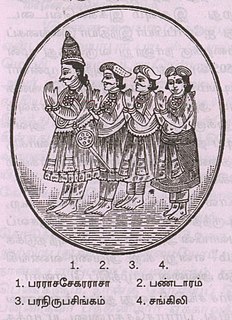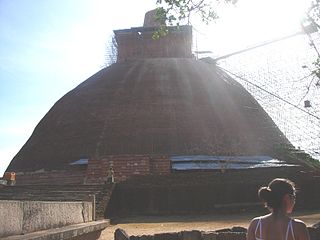
The Pandya dynasty was an ancient Tamil dynasty of South India, one of the three Tamil dynasties, the other two being the Chola and the Chera. The kings of the three dynasties were referred to as the Three Crowned Kings of Tamilakam.

Jatavarman Sundara Pandyan I, also known as Sadayavaramban Sundara Pandyan, was king and of the Pandyan dynasty, ruling regions of Tamilakkam (present day South India between 1250–1268. He is remembered for his patronage of the arts and Dravidian architecture, along with refurbishment and decoration of many Kovils in the Tamil continent. He oversaw a massive economic growth of the Pandyan kingdom. On the eve of his death in 1268, the second Pandyan empire's power and territorial extent had risen to its zenith.

The Jaffna Kingdom, also known as Kingdom of Aryachakravarti, of modern northern Sri Lanka was a historic monarchy that came into existence around the town of Jaffna on the Jaffna peninsula traditionally thought to be established after the invasion of Magha, who is credited with the founding of the Jaffna kingdom and is said to have been from Kalinga, in India. Established as a powerful force in the north, north east and west of the island, it eventually became a tribute paying feudatory of the Pandyan Empire in modern South India in 1258, gaining independence in 1323, when the last Pandyan ruler of Madurai was defeated and expelled in 1323 by Malik Kafur, the army general of the Muslim Delhi Sultanate. For a brief period, in the early to mid-14th century, it was an ascendant power in the island of Sri Lanka when all regional kingdoms accepted subordination. However, the kingdom was eventually overpowered by the rival Kotte Kingdom, around 1450 when it was invaded by Prince Sapumal under the Kotte Kingdom's directive.

The Arya Chakravarti dynasty were kings of the Jaffna Kingdom in Sri Lanka. The earliest Sri Lankan sources, between 1277 and 1283, mention a military leader of this name as a minister in the services of the Pandyan Empire; he raided the western Sri Lankan coast and took the politically significant relic of the Buddha’s tooth from the Sinhalese capital city of Yapahuwa. Political and military leaders of the same family name left a number of inscriptions in the modern-day Tamil Nadu state, with dates ranging from 1272 to 1305, during the late Pandyan Empire. According to contemporary native literature, such as Cekaracecekaramalai, the family also claimed lineage from the Tamil Brahmins of the prominent Hindu pilgrimage temple of Rameswaram in the modern Ramanathapuram District of India. They ruled the Jaffna kingdom from the 13th until the 17th century, when the last of the dynasty, Cankili II, was ousted by the Portuguese.

Kalinga Magha also known as Magha the Tyrant and Kulankayan Cinkai Ariyan,. He is identified as the founder of the Jaffna kingdom and first king of the Aryacakravarti dynasty. According to the Segarāsasekara-Mālai belong the first Aryacakravarti king of Jaffna to Eastern Ganga dynasty of Kalinga, who were descendants of Western Gangas and Cholas. His family was connected to the rulers of Ramanathapuram in Tamil Nadu. Kalinga Magha’s relatives of Ramanathapuram administered the famous temple of Rameswaram. He usurped the throne from Parakrama Pandyan II of Polonnaruwa, in 1215. His reign saw the massive migration of Sinhalese to the south and west of Sri Lanka, and into the mountainous interior, in a bid to escape his power. Magha was the last ruler to have his seat in the traditional northern seat of native power on the island, known as Rajarata; so comprehensive was his destruction of Sinhalese power in the north that all of the successor kingdoms to Rajarata existed primarily in the south of the island.

Chandrabhanu or Chandrabhanu Sridhamaraja was the King of Tambralinga Kingdom in present-day Thailand, Malaysia and Sumatra. A Javaka, he was known to have ruled from during the period of 1230 until 1263. He was also known for building a well-known Buddhist stupa in southern Thailand. He spent more than 30 years in his attempt to conquer Sri Lanka. He was eventually defeated by the forces of the Pandyan Dynasty from Tamil Nadu in 1263 and was killed by the brother of the south Indian Emperor Jatavarman Sundara Pandyan.
Maravarman Kulasekara Pandyan I was a Pandyan king, who ruled regions of South India between 1268–1308 CE, though Sen states he ruled until 1310. His death lead to the Pandyan Civil war in 1308-1323.

The Early Pandyas of the Sangam period were one of the four main kingdoms of the ancient Tamil country, the other three being the Cholas, the Cheras and Athiyamaan Dynasty. As with many other kingdoms around this period, most of the information about the Early Pandyas come to modern historians mainly through literary sources and some epigraphic, archaeological and numismatic evidence. The capital of the Early Pandyan kingdom was initially Korkai, Thoothukudi and was later moved to Koodal during the reign of Nedunjeliyan I. The kingdom lay to the south of the Maurya Empire of India.

There are literary, archaeological, epigraphic and numismatic sources of ancient Tamil history. The foremost among these sources is the Sangam literature, generally dated to 5th century BCE to 3rd century CE. The poems in Sangam literature contain vivid descriptions of the different aspects of life and society in Tamilakam during this age; scholars agree that, for the most part, these are reliable accounts. Greek and Roman literature, around the dawn of the Christian era, give details of the maritime trade between Tamilakam and the Roman empire, including the names and locations of many ports on both coasts of the Tamil country.
Maravarman Sundara Pandyan I was a Pandyan king, who ruled regions of South India between 1216–1238 CE. He laid the foundation for the Pandya revival, after being dominated by the Cholas for several centuries.
Arikesari Maravarman, also known as Arikesari Parankusa, was an Indian king from the Pandyan dynasty. He ruled parts of the present-day Kerala and Tamil Nadu. He expanded the Pandyan power substantially, and the Pandyan inscriptions credit him with several victories, including those over the Cheras ("Keralas") and the Pallavas.

Edaganathar Temple is a Hindu temple dedicated to the deity Shiva, located in Thiruvedagam, a village in Madurai district in the South Indian state of Tamil Nadu. The temple is located on the banks of Vaigai River. Shiva is worshipped as Edaganathar, and is represented by the lingam. His consort Parvati is depicted as Visalakshi. The presiding deity is revered in the 7th century Tamil Saiva canonical work, the Tevaram, written by Tamil saint poets known as the nayanars and classified as Paadal Petra Sthalam.
Maravarman Sundara Pandyan II was a Pandyan king, who ruled regions of South India between 1238–1240 CE.
Sadayavarman Kulasekaran I was a Pandyan king, who ruled regions of South India between 1190-1216.
Savakanmaindan was a monarch of the kingdoms of Tambralinga and Jaffna. He was the son of the Savakan king Chandrabhanu of Tambralinga who usurped the Tamil throne in 1255 AD. During his rule of Jaffna, the Venetian traveller Marco Polo visited the northeastern Tamil country.
Sena II was King of Anuradhapura in the 9th century, whose reign lasted from 866 to 901. He succeeded his uncle Sena I as King of Anuradhapura and was succeeded by his brother Udaya I.

Srimara Srivallabha was a Pandyan king who led the resurgence of the Pandyan dynasty. During the reign of Srimara Srivallabha, a number of irrigation projects were undertaken, which included renewing existing tanks, canals and sluices and brick and granite blocks were used as building materials. Water reservoirs like Sri Vallabha Pereri were also built in his reign.

Ninra Narayana Perumal Temple or Thiruthankaal in Thiruthangal, a town in the outskirts of Sivakasi in the South Indian state of Tamil Nadu, is dedicated to the Hindu god Vishnu. Constructed in the Dravidian style of architecture, the temple is glorified in the Divya Prabandha, the early medieval Tamil canon of the Azhwar saints from the 6th–9th centuries AD. It is one of the 108 Divyadesam dedicated to Vishnu, who is worshipped as Ninra Narayana and his consort Lakshmi as Arunakamala Mahadevi.

Kalugumalai Jain beds in Kalugumalai, a panchayat town in Thoothukudi district in the South Indian state of Tamil Nadu, are dedicated to the Jain and Hindu religious figures. Constructed in rock cut architecture, the unfinished temple is believed to have been built during the reign of Pandyan king Parantaka Nedunjadaiya. The rock-cut architecture at Kalugumalai is an exemplary specimen of Pandyan art. The other portions of Kalugumalai houses the 8th century unfinished Shiva temple, Vettuvan Koil and Kalugasalamoorthy Temple, a Murugan temple at the foothills.
Jayantavarman was an Indian king from the Pandyan dynasty. He ruled parts of the present-day Kerala and Tamil Nadu. He is also known as Seliyan Sendan, Sendan being the Tamil form of the Sanskrit name "Jayantan".












